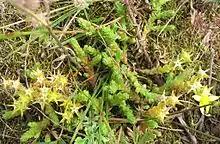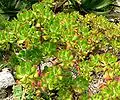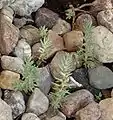| Sedums | |
|---|---|
 | |
| Genus: | Sedum |
| Family: | Crassulaceae |
| Type: | Perennials |
| Pollination: | Insects |
| Toxicity and edibility: | Some species are toxic |
Sedum, commonly known as rockcress, is a genus in the family Crassulaceae, members of which are broadly referred to as stonecrops. The genus consists of about 400 species of leafy succulents, found primarily, but not exclusively, throughout the northern hemisphere, varying from annual groundcovers to shrubs.
Description
The plants have water-storing leaves and a typical form of blossom with five petals, seldom four or six. There are typically twice as many stamens as petals.
Growing conditions
Well drained soils. Many sedums are extensively cultivated as garden plants, due to their interesting and attractive appearance and hardiness. The various species differ in their requirements; some are cold-hardy but do not tolerate heat, some require heat but do not tolerate cold. They are preferred over grass for green roofs, popular in Germany and some other countries.
Species
Well known European Sedums are Sedum acre, Sedum album, Sedum dasyphyllum, Sedum reflexum (also known as Sedum rupestre) and Sedum hispanicum.
Uses
Sedum reflexum, known as "stone orpine" or "crooked yellow stonecrop", is occasionally used as a salad leaf or herb in Europe (and the United Kingdom) . It has a slightly astringent sour taste
Sedum acre ("biting stonecrop") on the other hand contains high quantities of piperidine alkaloids (namely (+)-sedridine, (-)-sedamine, sedinone and isopelletierine) which give it a sharp, peppery and acrid taste and make it somewhat toxic. Depending on the amount consumed, irritations of the mucous membranes, cramps and paralysis, including respiratory paralysis may ensue. In ancient Greece, biting stonecrop was used to treat epilepsy and skin diseases, as well as to cause abortions.
Maintenance
Propagation
Pests and diseases


Leaf Blotch
- Septoria sedi
Crown Rot
- Pellicularia rolfsii
Stem Rots
- Colletotrichum
- Phytophthora
- Pellicularia filamentosa
- Meliodgyne incognita
- Melon Aphid: Aphis gossypii
- Green Peach Aphid: Myzus persicae
Scales
- Greedy Scale: Hemiberlesia rapax
- Black Vine Weevil: Otiorhynchus sulcatus
- Variegated Fritilary: Euptoieta claudia
Slugs and Snails
Gallery
 Sedum dendroideum
Sedum dendroideum Sedum glaucophyllum
Sedum glaucophyllum Sedum hybridum
Sedum hybridum Sedum ochroleucum
Sedum ochroleucum Sedum reflexum
Sedum reflexum Sedum spathulifolium
Sedum spathulifolium Sedum stenopetalum
Sedum stenopetalum Hylotelephium telephium ssp. maximum, formerly placed in Sedum
Hylotelephium telephium ssp. maximum, formerly placed in Sedum
References
- Britton, Nathaniel Lord; Addison Brown (1913). An Illustrated Flora of the Northern United States and Canada, Volume 2 (second edition ed.). Dover Publications, inc.. pp. 207-210.
- Ann Fowler Rhoads and Timothy A. Block (2000). The Plants of Pennsylvania: An Illustrated Manual. Anna Anisko, illustrator. Morris Arboretum, University of Pennsylvania Press. pp. 366-368.
- Christopher Brickell and Judith D. Zuk (1997). The American Horticultural Society A-Z Encyclopedia of Garden Plants. DK Publishing. pp. 948-951.
- Staff of the L. H. Bailey Hortorium (1976). Hortus Third: A Concise Dictionary of Plants Cultivated in the United States and Canada. Cornell University Press. pp. 1023-1030.
- Pirone, Pascal P. (1978). Diseases & Pests of Ornamental Plants (Fifth Edition ed.). John Wiley & Sons, New York. pp. 483-484.
- Cranshaw, Whitney (2004). Garden Insects of North America: The Ultimate Guide to Backyard Bugs. Princeton University Press. pp. 620.